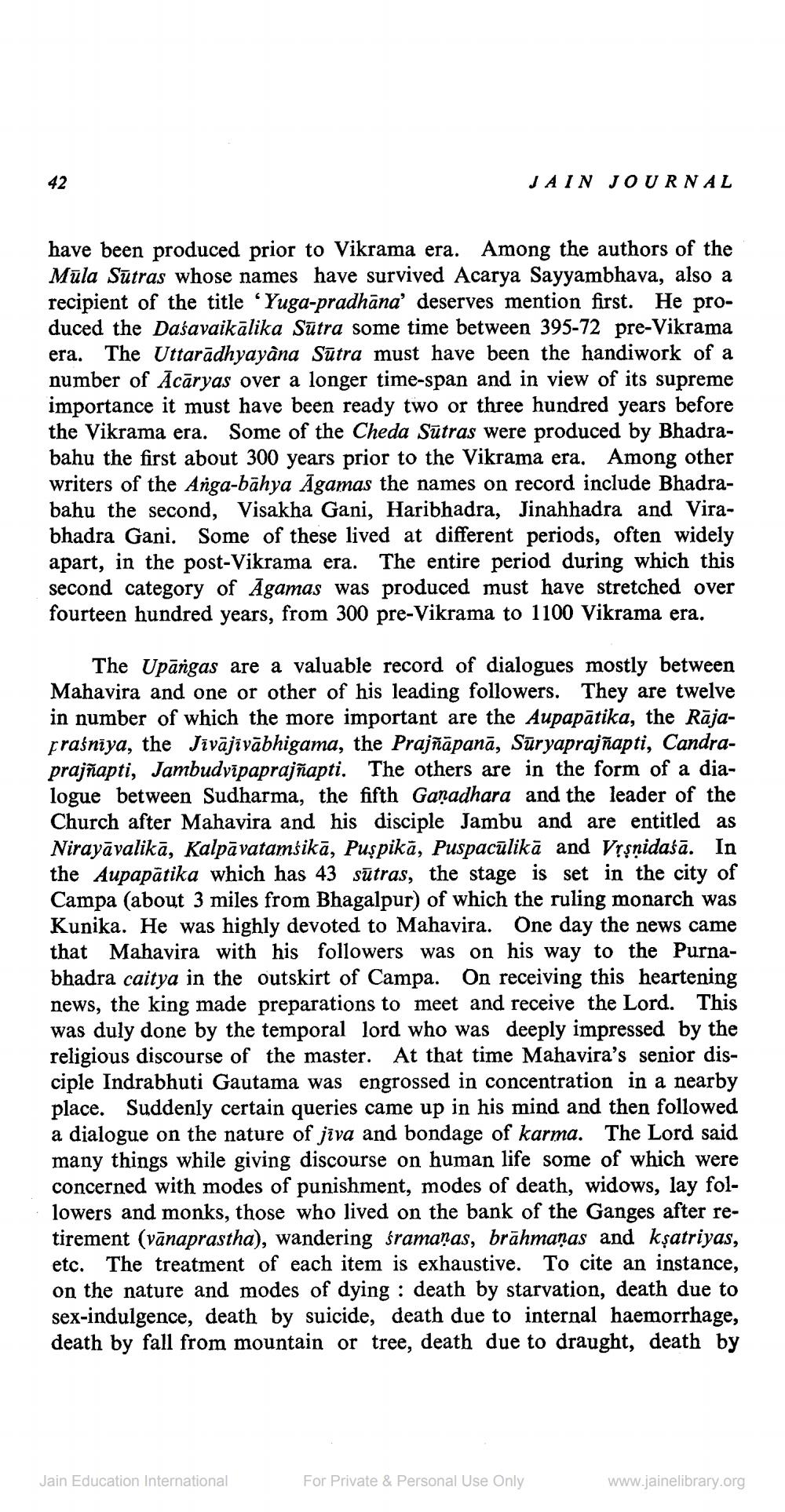Book Title: Jain Journal 1968 07 Author(s): Jain Bhawan Publication Publisher: Jain Bhawan Publication View full book textPage 7
________________ JAIN JOURNAL have been produced prior to Vikrama era. Among the authors of the Müla Sūtras whose names have survived Acarya Sayyambhava, also a recipient of the title “Yuga-pradhāna' deserves mention first. He produced the Daśavaikālika Sūtra some time between 395-72 pre-Vikrama era. The Uttarādhyayana Sūtra must have been the handiwork of a number of Ācāryas over a longer time-span and in view of its supreme importance it must have been ready two or three hundred years before the Vikrama era. Some of the Cheda Sūtras were produced by Bhadrabahu the first about 300 years prior to the Vikrama era. Among other writers of the Arga-bāhya Āgamas the names on record include Bhadrabahu the second, Visakha Gani, Haribhadra, Jinahhadra and Virabhadra Gani. Some of these lived at different periods, often widely apart, in the post-Vikrama era. The entire period during which this second category of Agamas was produced must have stretched over fourteen hundred years, from 300 pre-Vikrama to 1100 Vikrama era. The Upāngas are a valuable record of dialogues mostly between Mahavira and one or other of his leading followers. They are twelve in number of which the more important are the Aupapātika, the Rājapraśnīya, the Jīvājīvābhigama, the Prajñāpanā, Suryaprajñapti, Candraprajñapti, Jambudvīpaprajñapti. The others are in the form of a dialogue between Sudharma, the fifth Gañadhara and the leader of the Church after Mahavira and his disciple Jambu and are entitled as Nirayāvalikā, Kalpāvatamšikā, Puşpikā, Puspacālikā and Vịşnidašā. In the Aupapātika which has 43 sūtras, the stage is set in the city of Campa (about 3 miles from Bhagalpur) of which the ruling monarch was Kunika. He was highly devoted to Mahavira. One day the news came that Mahavira with his followers was on his way to the Purnabhadra caitya in the outskirt of Campa. On receiving this heartening news, the king made preparations to meet and receive the Lord. This was duly done by the temporal lord who was deeply impressed by the religious discourse of the master. At that time Mahavira's senior disciple Indrabhuti Gautama was engrossed in concentration in a nearby place. Suddenly certain queries came up in his mind and then followed a dialogue on the nature of jīva and bondage of karma. The Lord said many things while giving discourse on human life some of which were concerned with modes of punishment, modes of death, widows, lay followers and monks, those who lived on the bank of the Ganges after retirement (vānaprastha), wandering śramaņas, brāhmaṇas and ksatriyas, etc. The treatment of each item is exhaustive. To cite an instance, on the nature and modes of dying : death by starvation, death due to sex-indulgence, death by suicide, death due to internal haemorrhage, death by fall from mountain or tree, death due to draught, death by Jain Education International For Private & Personal Use Only www.jainelibrary.orgPage Navigation
1 ... 5 6 7 8 9 10 11 12 13 14 15 16 17 18 19 20 21 22 23 24 25 26 27 28 29 30 31 32 33 34 35 36 37 38 39 40 41 42 43 44 45 46 47 48 49 50 51 52 53 54 55 56 57 58 59 60
